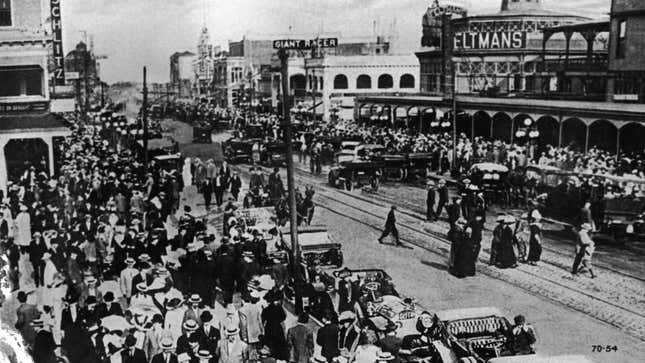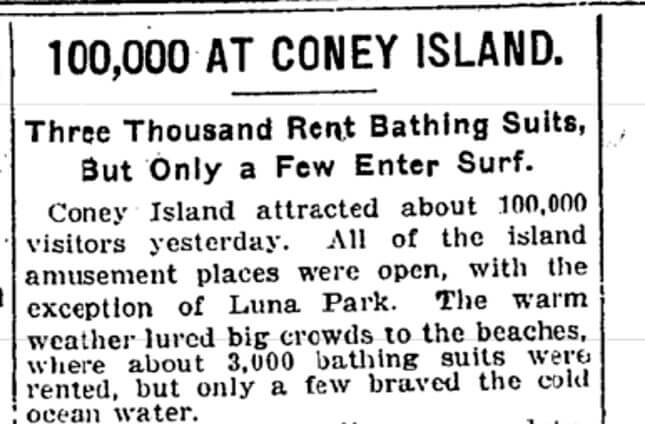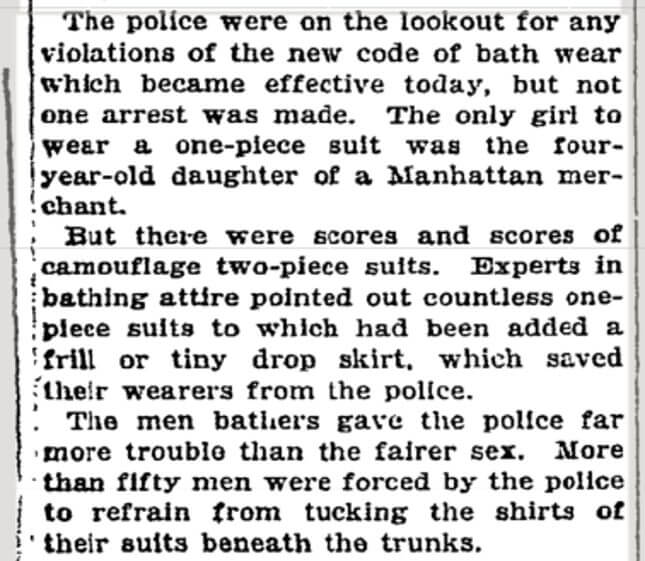Did You Know: Coney Island Visitors Used to Rent Their Bathing Suits
In Depth

Before everyone heads off to the nearest body of water to show off their cute new swim looks, you should know that a century ago, many visitors to Coney Island rented their bathing suits.
I learned this fact recently, while reading Hugh Ryan’s fascinating When Brooklyn Was Queer. Ryan goes into detail about the bathhouses on Coney Island, explaining that they a hybrid of two basic types of the form that emerged in New York City over the course of the 19th century—privately run institutions that catered to the middle and upper classes that functioned almost like social clubs, and municipal offerings that promoted a reformist notion of hygiene among the working class. Ryan wrote:
They were private run, but catered mostly to the working class. They served both social and hygienic roles. One of their primary functions was to rent bathing suits to city residents. Not only did few people own a bathing suit, but up until the late 1930s wearing bathing suits on city streets was prohibited, meaning you had to change somewhere at Coney.
You can get a peek of the process via this 2015 article at Mashable, which includes a turn-of-the-century shot of beachgoers underneath a bathing suit rental company’s banner proudly boasting “ALL SUITS STERILIZED.” The practice was still ongoing in 1921, when it casually pops up in this New York Times article as a convenient data point to assess how many people visited Coney Island one unseasonably warm March weekend.

At the turn of the century, a swimsuit was an expensive, elaborate, single-use getup within an economy where clothing ate up a high percentage of one’s income. A lot of the working-class New Yorkers crowding Coney Island’s shores wouldn’t have owned many items of clothing, period, especially compared to our modern era of fast fashion.
The archives also show plenty of instances of conflict over controlling just where you could wear these suits, as Ryan references. A 1920 article from the New York Times reported that “eighteen girls and 3 men” had been arrested for walking around in their swimsuits beyond the Far Rockaway beach, but in its vicinity, for instance along the boardwalk. Another article from the same month reported on the scene after Long Beach, Long Island had banned “one-piece” suits:

Ryan quotes from Michael Immerso’s Coney Island, The People’s Playground, which says that there more than 30 bathhouses by 1930 and paints the picture as they peaked in the 1920s:
Large bathhouses such as Steeplechase Baths, Ward’s, and Washington Baths charged about fifty cents for a locker and provided amenities such as a pool, handball court, punching bags, and a sunbathing deck. Raven Hall, one of the oldest, had a picnic grove and dance pavilion. Silver’s Bath and Staunch’s were known for their steam baths, which were popular with Russian and Jewish patrons. Less prestigious establishments with fewer amenities charged as little as fifteen cents. Bathhouses were one more link to the city’s poorer neighborhoods, where public baths were familiar institutions. Community solidarity was transferred to many of Coney Island’s bathing establishments, which gained a loyal following among a particular neighborhood group.
“Certain bathhouses, such as Stauch’s and the Washington Baths, would become particularly popular with gay men,” Ryan wrote. But basically, everybody used one or another during the era, because they were simply part of the social texture of Coney Island. It’s a perfect little illustration of the tiny, intimate details that made the past different in all sorts of unexpected and forgotten ways. Just a little something to ponder as you snap your straps onto your shoulders and shimmy into your coverup!